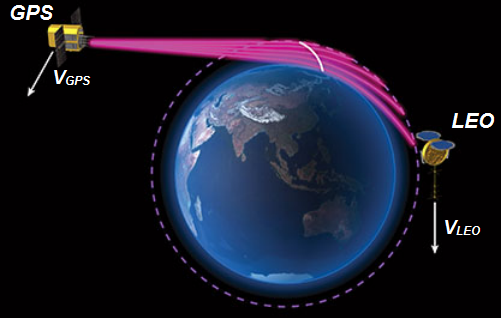GPSRO
The GPS radio occultation technique (Kursinski et al., 1997) uses satellite-to-satellite limb soundings between low-Earth orbiters and GNSS transmitters to measure accumulated refraction of the signal while it propagates through the atmosphere. Based on Doppler shift and known occultation geometry the so-called bending angle can be calculated and assigned to perigee points where the refraction is critical. The idea has its origin in extraterrestrial space missions to explore atmospheres of Mars (Fjeldbo and Eshleman, 1968) and Venus (Fjeldbo et al., 1971) in Mariner program. The proof-of-concept GPS/MET mission launched in 1995 was the first experiment on Earth’s atmosphere (Kursinski et al., 1996) that made the radio occultation technique an important tool for weather forecasting since the number of receiver platforms as well as new generation transmitters is constantly increasing. The most successful mission FORMOSAT-3/COSMIC which brought constellation of six low-Earth orbiters in 2006 provides both, ionospheric total electron density profiles for space weather applications and neutral atmosphere soundings that are operationally assimilated into numerical weather prediction models in the form of bending angle or refractivity profiles (Cucurull et al., 2007; Poli et al., 2010). Since COSMIC satellites already exceed their lifetime, the follow-on mission is planned to be launched on equatorial (expected in 2018) and polar orbits (under evaluation by NOAA’s Observing System Simulation Experiments) which together with growing EUMETSAT constellation of MetOp satellites will provide continuous retrievals.

Fig. Radio occultation event (source: cosmic.ucar.edu)
References:
Fjeldbo, G., Eshleman, V. R. (1968). The atmosphere of Mars analyzed by integral inversion of the Mariner IV occultation data. Planetary and Space Science, 16(8), 1035-1059.
Fjeldbo, G., Kliore, A. J., Eshleman, V. R. (1971). The neutral atmosphere of Venus as studied with the Mariner V radio occultation experiments. The Astronomical Journal, 76, 123.
Kursinski, E. R., Hajj, G. A., Bertiger, W. I., Leroy, S. S. (1996). Initial results of radio occultation observations of Earth’s atmosphere using the Global Positioning System. Science, 271(5252), 1107.
Kursinski, E. R., Hajj, G. A., Schofield, J. T., Linfield, R. P., Hardy, K. R. (1997). Observing Earth’s atmosphere with radio occultation measurements using the Global Positioning System. Journal of Geophysical Research: Atmospheres, 102(D19), 23429-23465.
Cucurull, L., Derber, J. C., Treadon, R., Purser, R. J. (2007). Assimilation of global positioning system radio occultation observations into NCEP’s global data assimilation system. Monthly Weather Review, 135(9), 3174-3193.
Poli, P., Healy, S. B., Dee, D. P. (2010). Assimilation of Global Positioning System radio occultation data in the ECMWF ERA–Interim reanalysis. Quarterly Journal of the Royal Meteorological Society, 136(653), 1972-1990.
